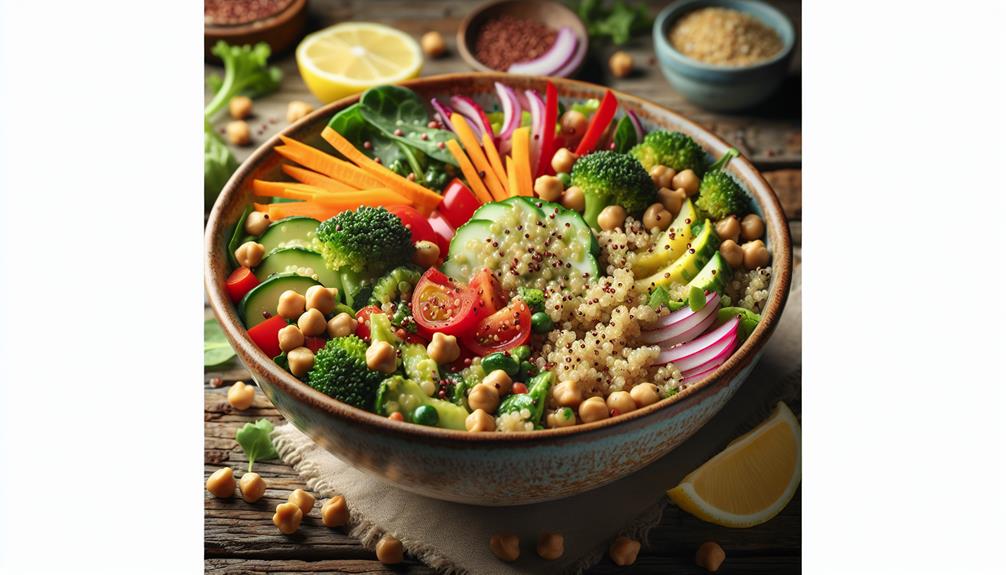If you've ever explored the world of grains, quinoa is like a hidden gem waiting to be discovered in your kitchen. Its versatility and nutritional benefits make it a standout choice for anyone looking to enhance their diet.
But how can you truly make the most of this super grain's potential? By understanding its unique qualities and incorporating it creatively into your meals, you'll unlock a whole new realm of culinary possibilities that not only nourish your body but also delight your taste buds.
Key Takeaways
- Quinoa is a complete protein source with all essential amino acids.
- Quinoa aids in digestion, weight management, and gut health.
- Quinoa offers diverse cooking options for flavorful meals.
- Quinoa is a versatile addition to plant-based diets for added nutrition.
Health Benefits of Quinoa
Quinoa offers a plethora of health benefits, making it a valuable addition to your diet. One of the key benefits of quinoa is its impressive protein content. Quinoa is considered a complete protein, containing all nine essential amino acids that your body needs but can't produce on its own. This makes it an excellent plant-based protein source for vegetarians and vegans.
Additionally, quinoa is rich in fiber, which is essential for digestive health. Fiber helps regulate bowel movements, prevents constipation, and supports a healthy gut microbiome. By incorporating quinoa into your meals, you can increase your fiber intake and promote overall digestive wellness.
The combination of protein and fiber in quinoa can also help you feel full and satisfied, making it a great option for weight management. Adding quinoa to your diet can offer a range of health benefits beyond just nutrition, making it a versatile and nutritious choice for your meals.
Quinoa's Nutrient Profile
When considering the nutrient profile of quinoa, it is essential to understand its diverse range of vitamins and minerals. Quinoa is not only a good source of carbohydrates but also offers a notable amount of protein and fiber. It contains all nine essential amino acids, making it a complete protein source, which is rare in plant-based foods. Additionally, quinoa is rich in fiber, providing around 5 grams per cooked cup. This high fiber content helps with digestion and promotes a feeling of fullness, which can be beneficial for weight management.
To give you a clearer picture, here is a table outlining the key nutrients found in quinoa:
| Nutrient | Amount per Cup (Cooked) | % Daily Value |
|---|---|---|
| Protein | 8 grams | 16% |
| Fiber | 5 grams | 20% |
| Iron | 2.8 milligrams | 15% |
Incorporating quinoa into your diet can be an excellent way to boost your protein and fiber intake while also benefiting from its iron content.
Cooking Tips for Quinoa

For optimal results when cooking quinoa, ensure you rinse it thoroughly before preparing. Rinsing helps remove quinoa's natural coating, called saponin, which can give it a bitter taste. To achieve a fluffy texture, use a ratio of 1 cup of quinoa to 2 cups of water or broth. Bring the liquid to a boil, add the quinoa, then reduce the heat to a simmer and cover for about 15-20 minutes until the liquid is absorbed.
When cooking quinoa, you can experiment with various savory seasonings to enhance its flavor profile. Consider adding garlic, onion, or herbs like thyme or rosemary during the cooking process. You can also mix in some soy sauce or a sprinkle of nutritional yeast for a umami kick.
Remember that quinoa is a versatile grain that can adapt to different flavors, so don't be afraid to get creative with your seasonings. By following these cooking tips, you can elevate your quinoa dishes with a fluffy texture and delicious savory undertones.
Quinoa Recipes for Inspiration
To expand your culinary repertoire and make the most of your quinoa cooking skills, exploring a variety of flavorful and nutritious recipes can offer you a world of inspiration. Quinoa salads are a popular choice, combining quinoa with fresh vegetables, herbs, and a zesty dressing for a refreshing dish. You can customize your quinoa salad with ingredients like cherry tomatoes, cucumbers, avocado, and feta cheese to suit your taste preferences.
Quinoa bowls are another versatile option that allows you to get creative with different flavor profiles. Try a Mexican-inspired bowl with quinoa, black beans, corn, salsa, and avocado for a tasty and satisfying meal. Alternatively, a Mediterranean quinoa bowl with olives, roasted vegetables, hummus, and a drizzle of tahini offers a unique twist.
Experimenting with quinoa recipes like salads and bowls can help you incorporate this super grain into your diet in delicious and exciting ways while reaping its numerous health benefits.
Incorporating Quinoa Into Your Diet

Incorporating quinoa into your diet can significantly enhance your overall nutritional intake and provide a delicious and versatile option for meals. This super grain isn't only packed with nutrients but also offers a pleasant nutty flavor that can complement a variety of dishes.
To make the most of quinoa in your diet, consider the following tips:
- Quinoa salads: Mix cooked quinoa with fresh vegetables, herbs, and a light vinaigrette dressing for a refreshing and nutritious salad option.
- Quinoa breakfasts: Start your day with a protein-rich breakfast by incorporating quinoa into your morning routine. Try quinoa porridge topped with fruits and nuts for a hearty and filling meal.
- Quinoa bowls: Create customizable quinoa bowls by adding your favorite proteins, veggies, and sauces to a base of fluffy quinoa for a well-balanced and satisfying meal.
- Quinoa stuffed vegetables: Use quinoa as a stuffing for bell peppers, tomatoes, or zucchinis for a flavorful and wholesome dish that's both tasty and nutritious.
Frequently Asked Questions
Can Quinoa Be Safely Consumed by Individuals With Celiac Disease or Gluten Intolerance?
Yes, quinoa is a safe option for individuals with celiac disease or gluten intolerance. It serves as a nutritious alternative to gluten-containing grains. When considering quinoa substitutes and recipes, it can enhance your meals and provide essential nutrients.
Are There Any Potential Side Effects or Risks Associated With Consuming Quinoa?
When consuming quinoa, be mindful of potential quinoa allergies. Enjoy the benefits by practicing portion control and varying cooking methods. Stay informed about any risks associated with consuming quinoa to make the most of this super grain.
How Does the Cultivation of Quinoa Impact the Environment?
Cultivating quinoa can have a positive environmental impact when done sustainably. This super grain requires less water than traditional crops, helps prevent soil erosion, and promotes biodiversity. Sustainable farming practices are key for long-term environmental health.
Is There a Difference in Nutritional Value Between Different Colors of Quinoa (White, Red, Black)?
Yes, there are slight differences in nutritional value among quinoa colors. While all are nutritious, red and black quinoa contain more antioxidants due to their outer coatings. Cooking methods may vary slightly, but all types offer health benefits and diverse culinary uses.
Are There Any Special Considerations for Incorporating Quinoa Into a Child's Diet?
When introducing quinoa to picky eaters, blend it into dishes like meatballs or muffins for sneaky nutrition. Play with textures to find what fits school lunches. Experiment with kid-friendly recipes that make quinoa fun.
Conclusion
Incorporate quinoa into your diet to experience its numerous health benefits and nutrient-rich profile. Whether you enjoy it as a side dish, salad, or in a main course, quinoa is a versatile super grain that can elevate your meals.
So, next time you're looking for a nutritious and delicious addition to your plate, consider reaching for a bowl of quinoa – your body will thank you for it.













